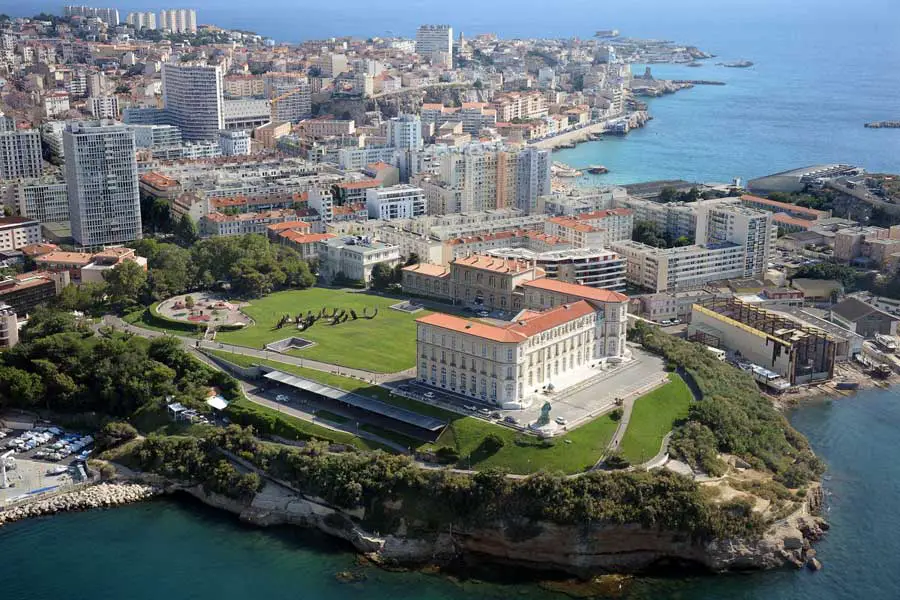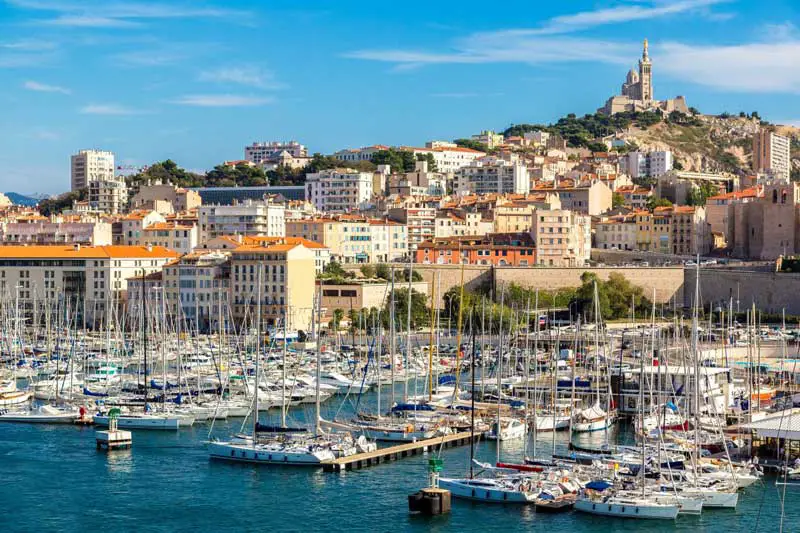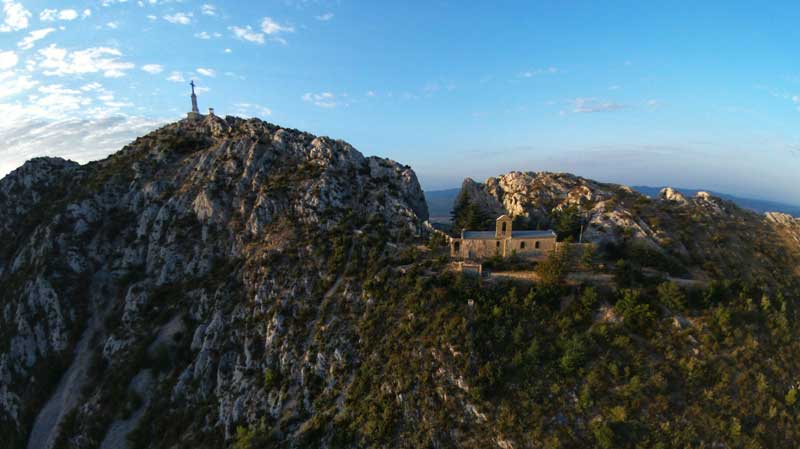About Marseilles, France
Marseille, a port city in southern France, has been a crossroads of immigration and trade since its founding by the Greeks circa 600 B.C. At its heart is the Vieux-Port (Old Port), where fishmongers sell their catch along the boat-lined quay. Basilique Notre-Dame-de-la-Garde is a Romanesque-Byzantine church. Modern landmarks include Le Corbusier’s influential Cité Radieuse complex and Zaha Hadid’s CMA CGM Tower.
Plan and Book:



Overview
Marseille is France’s second largest city, but it often goes unnoticed and unvisited by travelers who choose to spend their time in France either in Paris or along the sunny beaches of St. Tropez, Cannes, and Nice. They are missing out on one of France’s most diverse cities, both in terms of people and activities. Marseille has a fascinating history. Founded by the Phoenicians in the sixth century BC, Marseille has long been one of the more important port cities in the world. During the Middle Ages, the city was a focal point of the Crusades, as access to Marseille’s port was an important stop on the way to the Holy Land. During the reign of the French monarchy, its strategic importance was reemphasized as a military stronghold.

Even today, Marseille’s port is the second busiest in all of Europe, trailing only Rotterdam. A famous local legend revolves around Les Trois Maries, or The Three Marys. St. Lazarus awoke the three saints, including Mary Magdalene, and brought them ashore in Marseille, in order to Christianize the area. More recently, an army of French volunteers from Marseille marched to Paris during the French Revolution. Their battle song, La Marseillaise, became the country’s national anthem. (If you’re having a problem remembering how it goes, think of the opening notes of the Beatles classic, All You Need Is Love. )
Today, Marseille faces the same problems as any growing city. Crime is an issue, as is racial tension between the native French population and the arriving North African immigrants. Twenty-five percent of the population in Marseille is of North African descent, and that number is growing. But the city has come to embrace its newfound diversity, and is eager to put its best foot forward to attract a piece of the ever-growing tourism industry.
Majestic cliffs, sea as far as the eye can see, exceptional fauna and flora: that is the dream setting of the calanques of Marseille. This is a unique site, allowing nature lovers to enjoy various activities such as scuba-diving, yachting (boat, kayaking, paddle), trekking, climbing under a heady sun and blissful tranquility.

Attractions and Activities
With a busy harbour and a vibrant urban energy, Marseilles appeals to visitors seeking an authentic tourist experience. This cosmopolitan city is France’s oldest and the second largest after Paris and has much to offer, from ancient history and cultural diversity to gorgeous seaside scenery. Everywhere in Marseille, visitors are close to the serene blue waters-whether walking along a charming old street with a view, or feeling the refreshing sea breeze. The city’s colourful, multiethnic heritage also makes Marseille a fascinating place. Considered the bridge between Europe and North Africa, Marseille is home to a sizable emigrant population from Algeria. It’s possible to find traditional Arab souks as easily as a classic French bouillabaisse.
le Vieux Port (old harbour): watching fishermen selling their stock by auction is a must. Arriving to Marseille in the Vieux-Port on a summer evening is something you will never forget… You can watch this show by going to Frioul islands or Chateau d’If and going back late in the afternoon. there is also a nice view on the harbour from the Palais du Pharo (Pharo Palace). The famous Canebiere avenue goes straight down the harbor. However the Canebiére is not that interesting despite its reputation. Panier means basket in French, but in Marseille it is the name of the oldest area of the town. In the middle of this area there is the Vielle Charité, a wonderful old monument, now hosting museums and exhibitions.
MuCEM, the 2013-opened Museum of European and Mediterranean Civilisations is now famous for its unique architecture and intergration with the Fort Saint-Jean, castle which is now a free part of the museum, acting as a park in the city with breathtaking views.
Notre Dame de la Garde: the big church which overlooks the city. Old fishermen used to have their boats blessed in this church. You can still see many boat models hanging around in the church. From there it is one of the nicest view of the city. You can use the tourist train from the Vieux Port to reach the church – you can get off the train, look around and board a later train back to the port.
Musee des Docks romains (Archéologie-Graffiti-Lapidaire) (the old harbour from Phoenician and Roman times), Place Vivaux, 13002 Marseille. Tel: 04 91 91 24 62
Musee d’Archéologie méditerranéenne (Archéologie-Graffiti-Lapidaire), Centre de la Vieille Charite, 2 Rue de la Charite, 13002 Marseille. Tel: 04 91 14 58 59, Fax : 04 91 14 58 76
le Cours Julien and la plaine: a hangout area with bookstores, cafés, fountains, and a playground for the small ones (metro stop Cours Julien/Notre Dame du Mont). It is THE trendy area of Marseille. La Plaine is the local name for Place Jean Jaurés close to Cours Julien. Every Thursday and Saturday morning the Plaine market is the place to shop. If you are there early enough you can make very good deals, even if what you’ll find there is sometimes “tombé du camion” (fallen off the truck) as one says in Marseille.
la Corniche: a walkway and a road by the sea that provides lovely views of the sea, the Chateau d’If to the south, and les Calanques to the east. Vallon des Auffes, small pitoresque port under a viaduc, is particularly remarquable.
Boulevard Longchamp and Palais Longchamp (Longchamp casttle and avenue). From the Reforme church (up the Canebiére) you can follow the Boulevard Longchamp where you can see nice example of old upper-class buildings to arrive to Palais Longchamp. The palais is worth visiting though it won’t take you long. You can visit the “musee des beaux arts” as well as the natural history museum.
Parc Borély (Borely park). A large and great park, 300 metres from the sea. After a siesta in the park go have a drink at Escale Borely (a place with numerous restaurants and bars on the beach) to see the sunset.
Several beaches exist in Marseille. The most typical are Catalans, Prophétes, Pointe-Rouge and Corbieres. However, after a big rain, some of them might be polluted and then closed. Nice places to swim and relax on the sea are also to be found on the Corniche, on the rocks ahead of Vallon des Auffes, and next to the military camp in Malmousque.
Unité d’Habitation: designed by Le Corbusier. The building is called “la maison du fada” (the house of the foolish) by indegenous people. The building contains a shopping street, a church, a children’s school and housing. You can access the roof and enjoy the breathtaking view of Marseille between hills and sea (10am-6pm). There is a bar/restaurant/hotel on the 3rd floor too. Take bus 21 from Rond-Point du Prado metro.
Stade Velodrome: the stadium where the local football team “Olympique de Marseille” plays. Football matches are one of the highlights of Marseilles life. Whilst L’OM have fallen on rather lean times the former champions of Europe are the biggest football team in France. The atmosphere at the stadium is fantastic and whilst visitors are unlikely to get tickets for the popular Virage Nord or Sud seats in the Tribune Ganay offer an excellent view and a chance to soak up the atmosphere. Best games involve teams with some travelling support such as St Etienne, Lens or the grand-daddy match of them all against the evil Paris St Germain. Tickets can be bought (ideally several days before the game) either on-line or from the L’OM shop at the Vieux Port.
Noailles: The area around the Noailles sub-way station is one of the city’s most interesting. Lined with Arabic and Indo-Chinese shops some of the streets could be part of a bazzaar in Algeria. A fascinating area.

The Sainte Victoire remains a well-known place where you can simply enjoy a walk (trekking, mountain biking) and for rock climbing. Different routes allow ramblers to reach a priory (XVIIth century, pilgrimage) and to the Provence Cross where the magnificent panorama on the Provencal mountains and the rolling plains of the Aix region (Pays d’Aix) rewards the adventurous. This splendid circumnavigation of the mountain offers an itinerary including splendid viewpoints and the option to take rests in the surrounding little villages.
